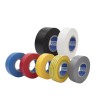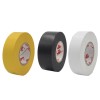What colours are available for insulating tape? All the shades
What colours are available for insulating tape? Electricians’ toolboxes are typically very colourful. Pliers, screwdrivers, testers, clamps, scissors, combination wrenches, ratchet handles, allen wrenches, hammers, measuring tapes, but above all... insulating tape of all colours.
And, looking at all those colourful rolls of adhesive tape, it is natural to wonder, at least once, about the reason for that curious, colourful choice. Why should an electrician need different colours of insulation tapes?
Wouldn’t it be enough to just have black or grey insulating tape? In fact, in terms of functionality, there is no difference between a red or white roll, nor between a black and, of course, yellow, or green one.
It is still insulating adhesive tape, in any case, and therefore a slightly elastic, particularly low conductivity tape, with an adhesive side.
But if neither the functionality nor the technical characteristics of the tapes change, what is the difference between the various colourful insulating tape rolls, and why there are sets of insulating tapes containing 9 different colours on the market?
What colours are available for insulating tape?
Let’s start by answering this question: what colours are available for insulating tape?
In reality, it could be said that there is no finite list, and therefore, if we looked long enough, we could find so many different hues each time, each manufacturer using a different one.
In principle, however, electricians’ coloured insulating tape roll sets contain roughly the same colours.
Let’s consider, for example, the 9 rolls set that can be purchased from our professional adhesive tape e-commerce website: here, it is possible to find three basic colours, i.e., black, white, and grey; next to them are the properly colourful insulating tape rolls, that is, the blue, green, yellow, red, brown, and bicolour ones, not to mention yellow and green.
But, having established that, technically, these tape rolls are actually all the same, why are there different colours?
Why are insulation tape rolls colourful
It is not the usage characteristics of these adhesive rolls that change, nor are the technical features such as mechanical grip or durability. The only thing that changes are the concepts attributed to the various colours.
To understand why, it is necessary to keep in mind that there are shared rules regarding electrical cables colours, making it possible for electrician to intervene effectively and safely on any electrical system, even if they are not the ones who set it up.
Electrical wire colours are, therefore, very precise messages for those who can interpret them, and this is also true for insulating tape colours, which make it possible to mark the nature – or function – of an electrical wire even if it is not, itself, colourful (for example, when you’re dealing with white cables) or if the colour is faded, or if for one reason or another a certain colour has been misused. All that remains to do, then, it to understand what the rules regulating the use of colours in electrical set-ups are!
The current legislation and the colour of electrical wires
The reference standard is CEI UNEL 00721, in which the use cases of differently coloured wires are identified. In fact, inside a normal electrical set-up, it is enough to be able to identify 4 different colours, namely:
· Black, recommended for phase conductors
· Brown, recommended for phase conductors
· Yellow green, recommended for grounding protective conductors
· Blue, recommended for neutral conductors
What does that mean? It means, for example, that yellow-green cables, or cables marked with an insulating tape of these two colours, is used as a protection, and therefore to discharge to the ground any loss of electricity in case of failure.
Black or brown are the two typical cables that are found in AC systems, through which high voltage current flows. Blue, for its part, signals cables dedicated to return current, which returns to the circuit after use.
It goes without saying, then, that the different colours on each cable are motivated by the need to make the various electrical wires always recognizable, to make sure the “system” can be interpreted correctly: colourful insulation tape makes it possible to extend and reiterate this useful system!







